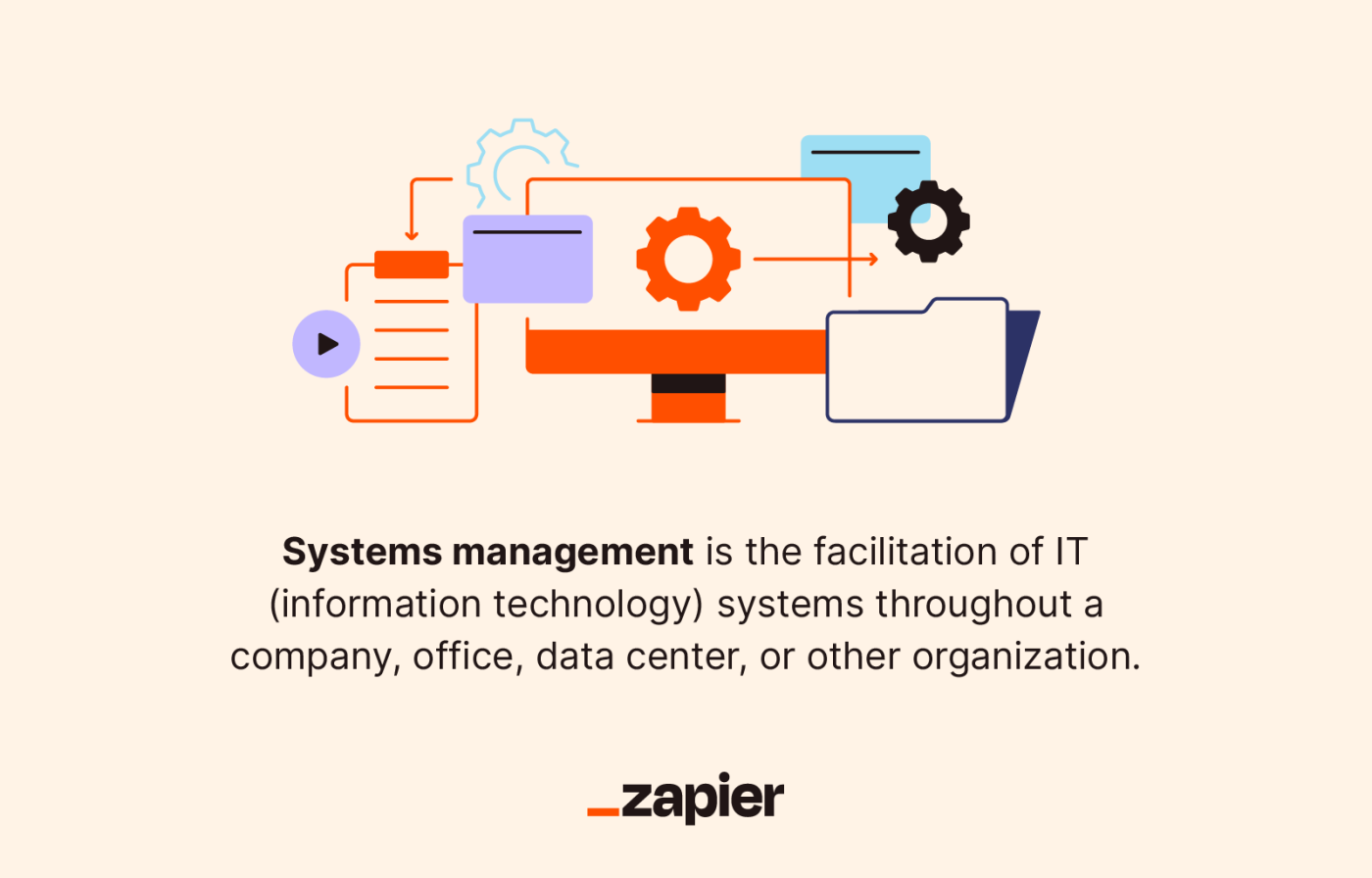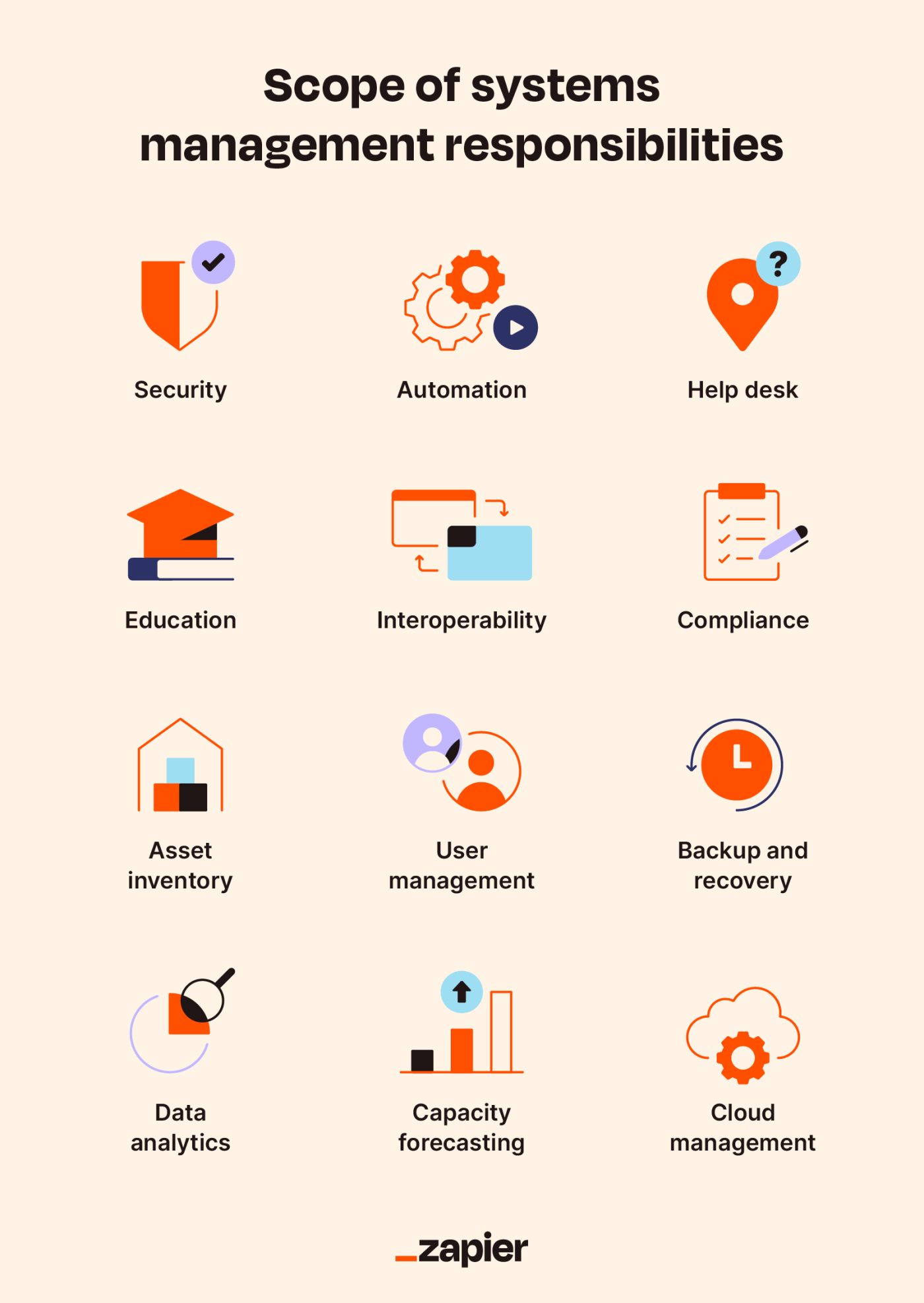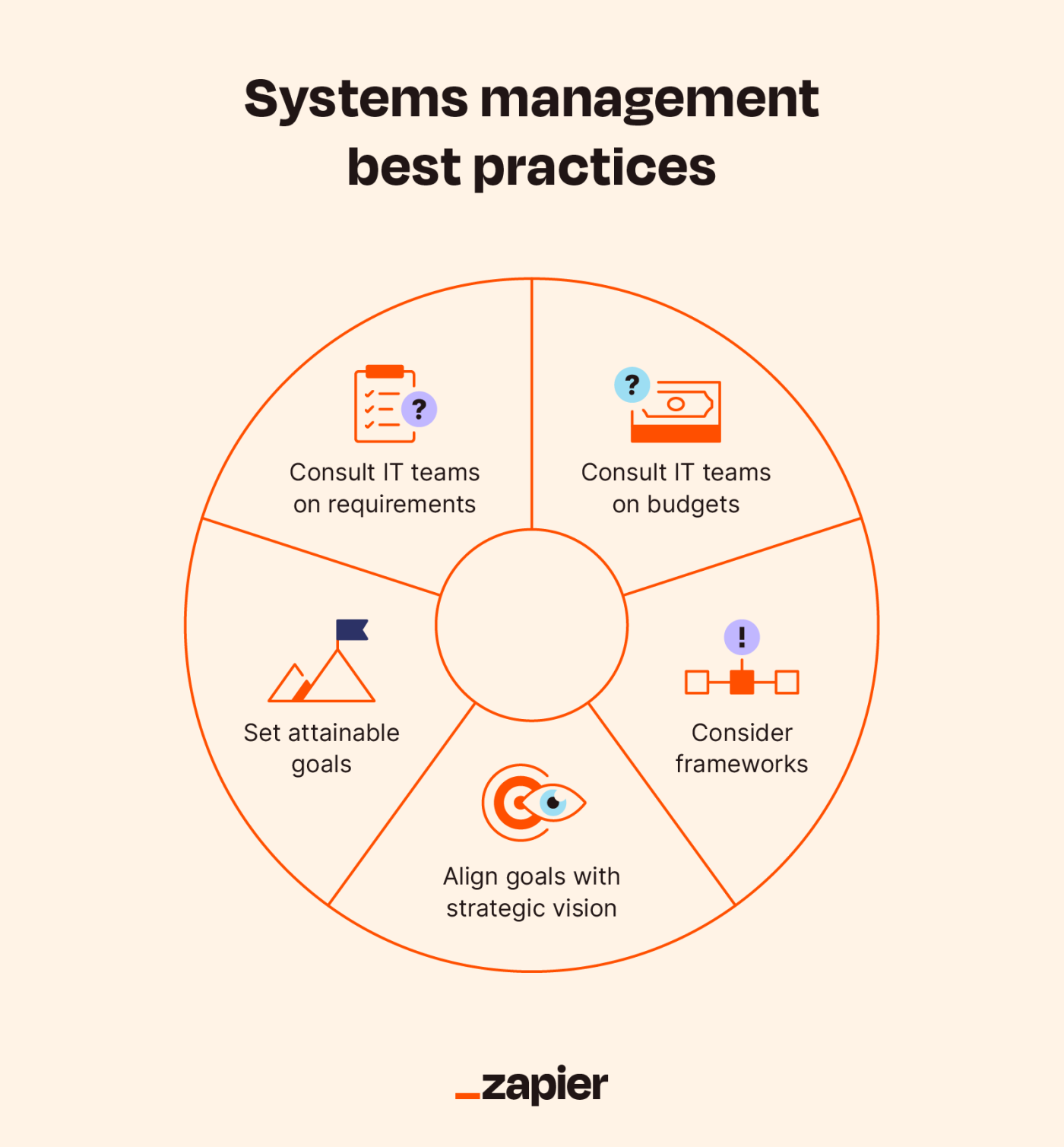Millions of pieces of data run through our minds each second, and we only notice a tiny fraction of them. That means countless memories, experiences, and sensations are being used at any given moment to drive nearly everything we do and think—almost entirely without conscious thought.
If you walk the other way when you see a Chihuahua, it may be because your neighbor's grouchy little bug-eyed monster chased you when you were a toddler. If you love nutmeg, maybe pumpkin spice candles were burning nonstop in your house when you were growing up.
Systems management works like that and, incidentally, also requires a lot of brain power from the IT teams that oversee it. They work hard to keep data and networks running so smoothly that no one else even needs to think about what they're doing.
Table of contents:
What is systems management?
IT systems management is the behind-the-scenes work that keeps an organization's IT running smoothly. It plays a key role in information systems and covers everything from maintaining networks and troubleshooting issues to automating processes and securing data—all so employees can focus on their jobs without thinking about the technology powering them.
Think of systems management like an engine. IT teams are the mechanics—monitoring performance, replacing outdated parts, fine-tuning operations, and setting up automation. Whether they're configuring cloud storage, managing software updates, or keeping security threats at bay, they keep the digital gears turning without a hitch.

What is the purpose of IT systems management?
The purpose of systems management is to keep networks, technology, and overall IT infrastructures running smoothly.
In a basic office setting, systems management could be as simple as having a single IT person who works on the website, keeps software updated across the office, and supports the rest of the staff's tech needs. On a more complex level, it could include a whole team responsible for managing servers, setting up robotic process automation, and programming AI.
Systems management covers a variety of tasks, including:
Security: Systems management includes data- and network security-related operations and assets like firewalls, virus protection software, 2FA, password/login standards, phishing detection, and even the physical security of hardware.
Asset inventory: An organization's hardware, software, and digital assets also fall under systems management, including servers, computers, files, and product licenses.
User management: All the logins, permissions, and subscriptions for the SaaS products, applications, devices, and software used across an organization fall into this category.
Backup and recovery: Systems management also covers fail-safety measures like data backup and recovery procedures.
Data analytics: Processes for extracting, logging, transferring, synthesizing, and analyzing data also fall under systems management.
Automation: IT teams work together with other teams in an organization to set up and refine triggers that automatically execute tasks and processes like reporting, notifications, emailing, and logging data.
AI: AI plays a big role in this space. It helps teams scale automation efforts, optimize workflows, and predict system failures before they happen. Machine learning models can analyze system performance, detect anomalies, and even automate troubleshooting, allowing teams to focus on high-impact tasks.
Capacity forecasting: Will your current data center support your needs in 10 years? Five years? Next year? Systems managers can assess your infrastructure at scale to help sustain your growth.
Cloud management: Whether it's public, private, or both, whatever your cloud computing needs are, good systems management can ensure you've got the security, utility, and capacity you need.
Help desk: For organizations with client-facing support ticketing, systems management includes issue resolution processes.
Interoperability: Effective systems management ensures that all of your separate software and applications play well together and fit neatly into your workflows.
Education: IT teams help train team members on how to use software and hardware and can train them on security best practices.
Compliance: Each of these responsibilities also has to maintain compliance, and IT teams have to be particularly cognizant of compliance as it relates to user data.
Remote management: With teams and devices spread across locations, IT needs the ability to monitor, troubleshoot, and update systems from anywhere. Remote management tools ensure that IT teams can keep networks secure, push critical updates, and resolve tech issues.
Incident response: When something goes wrong—like a security breach, server crash, or system outage—incident response kicks in. IT teams jump into action to diagnose the issue, minimize damage, and get everything back up and running as quickly as possible.
Disaster recovery planning: Disaster recovery planning ensures that data backups, failover systems, and contingency plans are in place so that a cyberattack, natural disaster, or hardware failure doesn't bring everything to a halt.
Patch and update management: Outdated software is a hacker's best friend, which is why patch and update management is a non-negotiable part of systems management. IT teams stay on top of security patches, bug fixes, and software updates to keep systems running smoothly and vulnerabilities locked down.

Common challenges when implementing systems management
Just like implementing a change in mindset, systems management implementations can cause a little friction. Here are a few potential challenges you might face when implementing a new system or IT management approach.
Learning curve: Any changes that come along with systems management may need additional training to execute. Within IT teams affected by those systems or changes that come from them, there may be resistance to alterations in job roles or processes.
Added complexity: It's often easier not to implement systems management strategies like automation or enhanced security, but the more complex workflows can be well worth it. Systems that lead to more efficiency should even simplify workflows down the road.
Cost: Good systems management costs money. Period. Specialized hires for IT teams may fetch high salaries, and the software and hardware needs required to scale can also add up.
Implementation: As systems management needs grow, organizations may run into roadblocks with existing applications and utilities. Interoperability can become an issue if changes aren't carefully considered early on.
Strain on current IT team: Existing teams may become overburdened by growing systems management needs.
Data migration difficulties: Moving data from one system to another sounds simple—until you're in the thick of it. Compatibility issues, downtime risks, and data integrity concerns can turn migration into a logistical headache if not carefully planned.
Scalability concerns: What works for a small team today might not cut it as your business grows. Without proactive planning, networks, storage, and software can become bottlenecks, slowing down performance, increasing costs, and making future expansion more complicated. Effective systems management needs to anticipate future demands.
Vendor lock-in: Some software solutions make it easy to get in but nearly impossible to leave. Vendor lock-in can limit flexibility, making it expensive or complex to switch providers when your business outgrows a tool or needs a better fit.
Unforeseen downtime: Even the best IT setups can't predict every hiccup. Whether it's a surprise system crash, a failed update, or a third-party outage, unexpected downtime can bring business operations to a halt.
Systems management best practices
No matter what your IT needs are, you can promote sound systems management with these strategies:
Consult IT teams on requirements: Nobody knows your systems management requirements better than your IT team. They can advise on network, interoperability, hardware, and utilization requirements to set a baseline.
Consult IT teams on budgets: Decision-makers should never assume their current teams have all the resources they need for continued growth. By consulting IT managers, they can solidify timelines and budgets for putting systems management plans into action.
Consider frameworks: Like a template, an established framework can help keep teams on track with a proven, pre-set structure like FCAPS for network security, FMEA for compliance, or COBIT for IT governance.
Align goals with strategic vision: Communicate across teams to understand overall strategic visions and organizational growth goals so that systems management goals can help advance them.
Set attainable goals: Since goals should be both attainable and measurable, consider another framework like ITIL for setting values and measurables. Including IT teams will help ensure their viability and timelines.
Prioritize security first: Security isn't just an IT concern; it's a business priority. From firewalls and encryption to access controls and employee training, every layer of protection helps prevent breaches and keep sensitive data safe.
Automate routine tasks: Repetitive tasks eat up valuable time, but automation can handle them in the background. Automating updates, backups, and system monitoring frees up IT teams to focus on bigger-picture projects.
Standardize processes: When IT workflows are all over the place, efficiency takes a hit. Standardizing processes, like onboarding, troubleshooting, and compliance checks, keeps things predictable, scalable, and easy to manage.
Document everything: Good documentation is an IT team's best friend. Whether it's system configurations, security policies, or troubleshooting guides, having everything written down in a knowledge base, spreadsheet, document, or systems management software helps with training, compliance, and problem-solving.
Regularly audit systems: A "set-it-and-forget-it" approach doesn't work in IT. Regular audits help catch vulnerabilities, inefficiencies, and outdated processes before they cause major issues.

What to consider when choosing a systems management software
Thinking about upgrading software or adding a new application? Consider consulting with your IT team or network admin on these points:
IT budget: Will licensing fees, registration costs, necessary hardware, or network upgrades fit into the budget? Will you need new hires? Budgeting for systems needs can be complex, and costs can add up quickly.
Timelines: You may need lengthy runways to account for onboarding, training, and early troubleshooting that could eat into productivity.
Existing resources: Take stock of all your current resources like applications, hardware, and staff certifications and skills. Make sure they can support your new software before committing to it.
Interoperability potential: If there are applications you depend on that would be a headache to change, your new software should be able to integrate with them—for example, if your team uses Agile project management software to track IT initiatives.
Size and scale: The size of your organization, the number of users who will need accounts for the new software, and your scale plans should all factor into the software choice and its pricing model.
Automate your systems management tools and ITSM products
IT system management software works best when all your tools communicate seamlessly. But with countless applications managing ITSM, network monitoring, security, and asset management, connecting them efficiently can be a challenge.
Zapier's AI automation platform allows IT teams to integrate all their apps and orchestrate workflows across the entire tech stack—from incident management and security monitoring to user provisioning and system updates.
Whether it's linking tools like Wrike, SolarWinds, ServiceNow, and Jira, triggering alerts based on system activity, or building out fully automated IT systems, Zapier helps IT teams eliminate silos and keep everything running smoothly—so your focus stays on strategy, not manual work.
Systems management FAQ
What is a systems management tool?
A systems management tool is software designed to monitor, maintain, and optimize an organization's IT infrastructure. These tools help IT teams track performance, automate tasks, enforce security policies, and manage networks, devices, and cloud services—all from a centralized dashboard.
What is an example of IT system management?
An example of IT system management is an IT team using remote monitoring software to track server health, apply security patches, and automate routine updates. Another example is using cloud management platforms to optimize storage, control access, and ensure seamless scalability as business needs grow.
What is the role of a systems manager?
A systems manager oversees the IT infrastructure that keeps an organization running. Their job involves maintaining networks, troubleshooting issues, managing security protocols, optimizing performance, and ensuring all IT systems work together smoothly. Whether they're configuring cloud resources, deploying automation, or handling disaster recovery, they keep the digital wheels turning.
Related reading:
This article was originally published in January 2023. The most recent update, with contributions from Hachem Ramki, was in March 2025.








